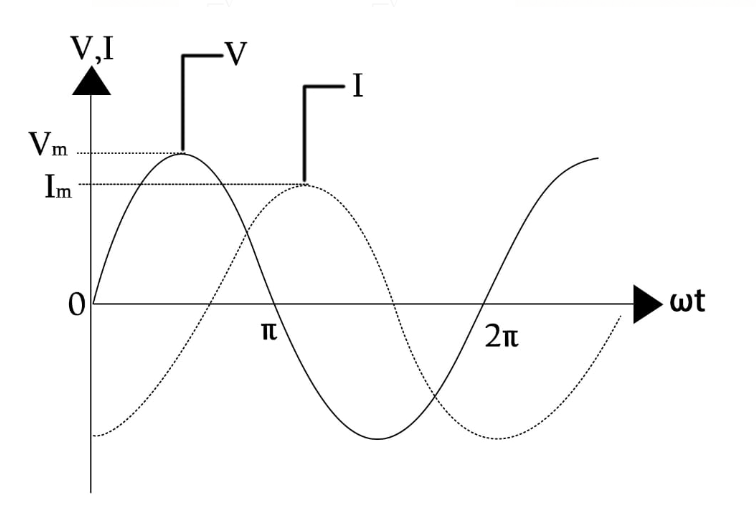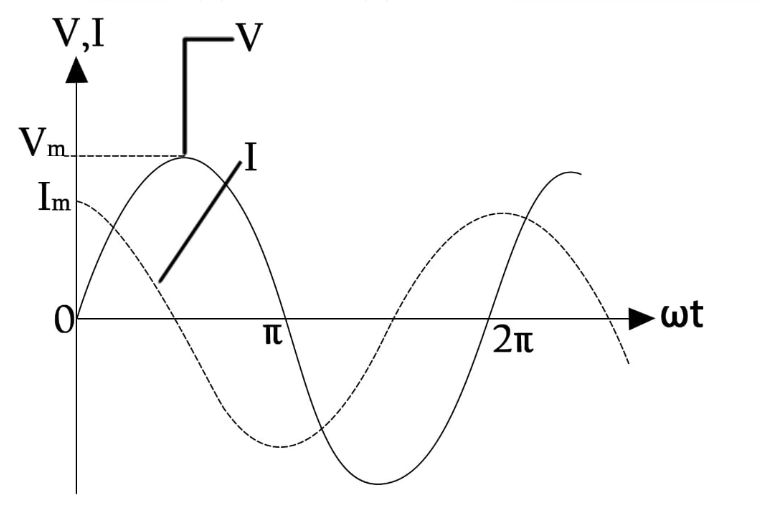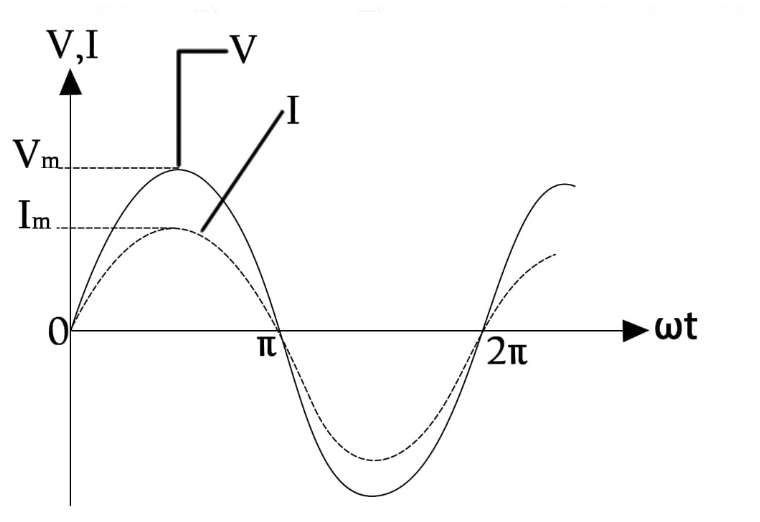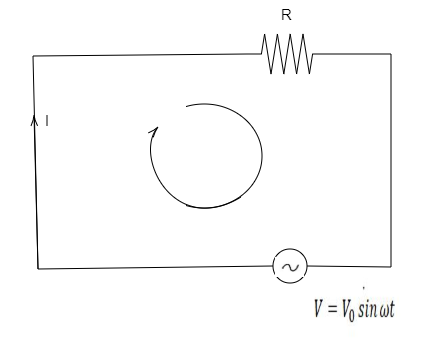
The phase relationship between current and voltage in a pure resistive circuit is best represented by.
A. 
B. 
C. 
D . 
Answer
225.3k+ views
Hint: A pure resistive circuit consists of an AC source and a resistor. There is no phase difference between voltage and current and the current and voltage is said to be in-phase.
Complete step by step answer:
It is given that the circuit is pure resistive which means that there is a resistor in the circuit along with an AC source.

Here ${\text{I}}$ is the current through the circuit and AC source has ${{\text{V}}_{\text{0}}}$ is the voltage difference and ${\text{R}}$ is resistance of the circuit.
Apply Kirchhoff’s law in the given circuit.

Appling Kirchhoff’s law,
$
{V_0}\sin \omega t - I \cdot R = 0 \\
I = \left( {\dfrac{{{V_0}}}{R}} \right)\sin \omega t \\
$
So, here we can see that current in the same phase as of voltage but is less in magnitude then voltage.
The phase diagram in which both voltage and current are in the same phase and also the current is having lesser value than voltage. Let us observe each of the options and see which one is the correct answer for this problem.
In option A the value of current is lesser than that of voltage but there is phase difference in the diagram.
In option B the value of current is lesser than that of voltage but there is a phase difference that is present in the phase diagram.
In option C the value of current is lesser than that of voltage and the phase difference is zero in the phase diagram.
In option D the value of current is lesser than voltage but there is a phase difference in the phase diagram.
Therefore, option C is the correct answer for this problem.
Note: A phase diagram is used to show the relationship between two or more sine waves having the same frequency. While applying Kirchhoff’s rule if we follow the flow of current then we are proceeding from higher potential to the lower potential of the source.
Complete step by step answer:
It is given that the circuit is pure resistive which means that there is a resistor in the circuit along with an AC source.

Here ${\text{I}}$ is the current through the circuit and AC source has ${{\text{V}}_{\text{0}}}$ is the voltage difference and ${\text{R}}$ is resistance of the circuit.
Apply Kirchhoff’s law in the given circuit.

Appling Kirchhoff’s law,
$
{V_0}\sin \omega t - I \cdot R = 0 \\
I = \left( {\dfrac{{{V_0}}}{R}} \right)\sin \omega t \\
$
So, here we can see that current in the same phase as of voltage but is less in magnitude then voltage.
The phase diagram in which both voltage and current are in the same phase and also the current is having lesser value than voltage. Let us observe each of the options and see which one is the correct answer for this problem.
In option A the value of current is lesser than that of voltage but there is phase difference in the diagram.
In option B the value of current is lesser than that of voltage but there is a phase difference that is present in the phase diagram.
In option C the value of current is lesser than that of voltage and the phase difference is zero in the phase diagram.
In option D the value of current is lesser than voltage but there is a phase difference in the phase diagram.
Therefore, option C is the correct answer for this problem.
Note: A phase diagram is used to show the relationship between two or more sine waves having the same frequency. While applying Kirchhoff’s rule if we follow the flow of current then we are proceeding from higher potential to the lower potential of the source.
Recently Updated Pages
JEE Main 2025-26 Experimental Skills Mock Test – Free Practice

JEE Main 2025-26: Magnetic Effects of Current & Magnetism Mock Test

JEE Main 2025-26 Atoms and Nuclei Mock Test – Free Practice Online

JEE Main Mock Test 2025-26: Optics Chapter Practice Online

The work done in slowly moving an electron of charge class 12 physics JEE_Main

The value of the resistor RS needed in the DC voltage class 12 physics JEE_Main

Trending doubts
JEE Main 2026: City Intimation Slip and Exam Dates Released, Application Form Closed, Syllabus & Eligibility

JEE Main 2026 Application Login: Direct Link, Registration, Form Fill, and Steps

Understanding the Angle of Deviation in a Prism

Hybridisation in Chemistry – Concept, Types & Applications

How to Convert a Galvanometer into an Ammeter or Voltmeter

Ideal and Non-Ideal Solutions Explained for Class 12 Chemistry

Other Pages
JEE Advanced Marks vs Ranks 2025: Understanding Category-wise Qualifying Marks and Previous Year Cut-offs

JEE Advanced 2026 - Exam Date (Released), Syllabus, Registration, Eligibility, Preparation, and More

JEE Advanced 2026 - Exam Date (Released), Syllabus, Registration, Eligibility, Preparation, and More

Dual Nature of Radiation and Matter Class 12 Physics Chapter 11 CBSE Notes - 2025-26

Understanding Atomic Structure for Beginners

Understanding Electromagnetic Waves and Their Importance




